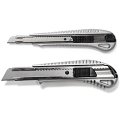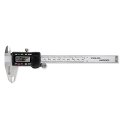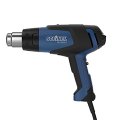Soldering Irons & Soldering Accessories
General information about soldering
Mankind has been soldering for thousands of years. This oldest of integral joining processes for joining metals was already being used around 3200 BC in Mesopotamia for working on gold parts. Examples of the use of soldering during the Middle Ages include church windows and organ pipes.
What is soldering?
Contrary to popular misconceptions, soldering is not the gluing of metals by means of the adhesive metal. In fact it is the alloying (blending) of the joining metal (the solder) with the surface of the piece to be attached. Glue-like joining by solder only occurs when the temperatures employed are too low (the parts themselves must reach the solder’s liquidus temperature for a true bond) – this so-called cold solder joint will come apart at the smallest amount of pressure.
Soft Soldering:
Soldering at temperatures up to 450 °C is referred to as soft soldering. In the do-it-yourself world it is the most used process. Soft soldering is done with a blowtorch or with gas or electric heated soldering irons (ones which produce between 15 and 500 W).
Soft solders are usually made out of tin and lead; for most bonds the so-called LSn 40 Pb, which is 40% tin and 60% lead, is used – the Radiolot LSn 60 Pb version is used for electro technology. Solders are made from metal alloys in such a way that when heated they will only gradually become liquid and not just melt (or solidify) immediately which would be the case with a pure metal.
Brazing (hard soldering):
Brazing refers to soldering done at temperatures over 450 °C. Brazed seams can achieve a much higher degree of strength - almost to the level of welded seams. Brazing devices are exclusively heated by means of gas: propane, butane or acetylene are employed - often in conjunction with oxygen - in order to attain even higher temperatures.
Because brazing requires more complicated devices we will only concern ourselves in the following section with soldering. Directions for brazing can be found in appropriate reference books.
Which metals can be soldered?
Some metals take to soldering better than others. There are two reasons for this:
The solder used for the bonding consists of lead and tin. Some metals (e.g. copper) are chemically very compatible with lead and tin. Their crystal structure has no problem bonding with that of the solder itself during the soldering process. These metals are therefore referred to as “solder friendly”.
The coating of oxide that inevitably develops on a metal and which must be removed before undertaking any soldering work has likewise an influence on the metal’s ability to be soldered. After the oxide coating has been removed from aluminium by rubbing it with abrasive paper, a new coat of oxide forms within seconds, thereby making it impossible to solder with customary solder and flux.
Metals that take well to soldering include:
• Tinplate (tin-plated sheet steel), copper, brass
• Copper, brass, zinc or spring steel with zinc chloride flux.
Aluminium, stainless steel and cast iron can only be soldered using a special flux after undergoing a special treatment beforehand. Chrome, titanium and silicon are hardly able to be soldered at all.
Soldering Irons
The soldering iron is the most important tool for soldering work. The differentiation of soldering irons is based on their power output and the temperatures achieved at the tip: soldering irons with a power output of 15 W reach a temperature of about 320 °C; 30 W soldering irons almost 400 °C and those with 60 W as much as 480 °C.
When trying to determine the right soldering iron for your job you should keep in mind that the soldering iron tip temperature is not the same as the working temperature (the temperature that is reached by the metal that is heated by the soldering iron after a short period of time). A basic rule of thumb: the working temperature of the iron is between 50 and 60% of the maximum soldering iron tip temperature. The tip of a 15 W soldering iron can only heat up a tiny area enough so that at that spot the solder will melt. The tip of a 60 W soldering iron, on the other hand, can heat up a much larger area to a temperature capable of melting the solder.
Conclusion: a 15 W soldering iron is powerful enough for spot soldering, for soldering thin wires, etc. If the wires are thicker than 2 mm or thin sheet metal is to be soldered, an iron with an output of at least (!) 30 W is recommended. If it can be that you will also want to do other work with your soldering iron like water pipe installations, a gas soldering iron should be chosen or, alternatively, an electrical soldering iron with 100 to 150 W power output.
Soldering iron tips:
The part that does the actual work during soldering is definitely the soldering iron tip. The decisive elements determining the quality of a solder joint are the right shape of the tip, perfect heat conductivity and flawless workmanship and reliability.
The classic soldering iron tip is made out of copper. Copper is an excellent heat conductor and is also reasonably priced but does have certain disadvantages. It oxidizes under the influence of heat and releases small particles of copper into the solder until the tip is finally completely eroded.
Long life Ersadur tips are made for extensive use because they possess a high degree of durability. The tips are galvanically plated with a layer of iron and subsequently have a layer of chrome added for protection against corrosion. Long-use soldering tips should always remain coated with solder because otherwise they will become somewhat passive and no longer make good contact with the solder. If this has already happened you can reactivate the tip by means of a flux and solder treatment. This treatment consists of wrapping the cold tip with solder that has a flux core and subsequently heating it up. If you are planning on doing a large amount of soldering work, we recommend that you purchase one of the somewhat more expensive longlife soldering tips.
Flux
Without flux the solder will lack stability. Practically all metals have a build-up of oxide on their surface when exposed to air. The solder must blend (alloy) with the metal’s surface and this oxide layer interferes with that process. By applying flux the oxide coat is removed and any further oxidation is prevented. At the same time, flux also prevents the momentary oxidation of the liquid solder which would impede its flow.
Most handicraft and radio solders already contain a flux filling, the so-called core. Soldering with these solders require no, or only a small amount of, additional flux.
Liquid solder and soldering grease are aggressive fluxes which are based on zinc chloride (ZnCl2). Liquid solder is actually a ZnCl2 solution that has been thinned with water; soldering grease is a petroleum jelly in which small drops of highly concentrated soldering fluid have been integrated. Because both flux types not only work on the metal but also the subsequently soldered area, any remaining flux residue must be removed.
How to solder
First and foremost is the preparation of the soldering iron: its tip should be as free as possible of combustion residue or flux residue. It is additionally recommended that the tip be tinned before every soldering job. This is done by tapping a small amount of solder on to the hot tip until a clean drop is formed.
Next, the assembly parts should be thoroughly cleaned (wire brush, abrasive paper…). Grease (e.g. finger prints) and the like should be removed with soap and water or alcohol. Do not use any cleaning agents! More and more cleaning agents contain silicone. Silicone, however, will seal a surface and thereby prevent the solder from taking. After that, the metal should be treated with, for example, abrasive paper or thinned citric acid so as to remove its oxide layer (citric acid can be found at a pharmacy; 1 tablespoon citric acid to 1 litre water. This mixture can be heated up to 80 °C in order to accelerate the process).
Then the flux should be applied and the proposed soldered area heated with the soldering iron while adding some solder; the solder should flow thinly over the area to be soldered. In doing this, the solder must melt on the metal and not on the soldering iron tip. The assembly parts should then be affixed on a fireproof substrate in such a way that even when being touched by the soldering iron they will not slide or shift around.
It is now the time for making your bond: the soldered seam must be heated with the soldering iron or blowtorch and more solder added there until a bond is made. Particularly important: in order to avoid making a cold solder, the assembly parts should be so hot at the seam that the solder will melt there even without the soldering iron being in use.
Now you’re almost done! The assembled parts must be allowed to remain in their tightly held position until they have cooled off - otherwise the seam can become brittle. Finally, remove any flux residue with running water.
Two more fundamental points:
The flux will evaporate if the area to be soldered stays hot too long. In addition, the solder will oxidize if it is heated too extensively. The result will be soldered areas on which the solder will have a matte appearance directly after the soldering work is completed. When that occurs, the assembly parts should be immediately separated again because they will anyway not remain joined very long. The actual soldering procedure should be done fairly quickly (the optimal time span for a spot solder is about 2 seconds – more than 5 seconds is definitely too long!).
A solder joint has only really been achieved when the solder has completely melted everywhere. This means that when soldering two metal parts with different thicknesses or sizes, the larger/thicker part must be “pre-heated” longer with the soldering iron than the smaller one. An even heating of BOTH metal parts is the prerequisite for an even flowing of the solder!
Well soldered?
A visual check will tell you whether the soldered area has taken or not. When done correctly, the solder melts completely on the metal during the actual soldering work and fills the joint very evenly. It must run smoothly over the surface of the metal much in the same way a drop of water will run when it has lost its surface tension as a result of detergent having been added.
Unmelted clumps of solder, partially open joints or “blisters” that are the result of too much solder being used on the metal parts are all indications that the soldering job should probably be done over again.
On the other hand, a “successful” load test whereby the soldered joint appears to have failed – especially in the case of thin wires or butt-jointed soldered sheets – need not necessarily indicate a bad soldering job: a soldered bond, as opposed to a brazed one, is primarily a conductive- , sealing- or affixing bond which should be able to conduct, for example, electricity or water. It is not designed for a high degree of, or permanent, tensile stress, compression load or sheer stress. In such instances brazing or welding is required.
How much solder is needed for which kinds of soldered bonds and other such concerns can best be determined by trial and error. Simply sit yourself down, heat up the soldering iron and try your hand with different metals with various thicknesses and compositions. It doesn’t take very long before you will develop a feel for the right amounts and the right timing.





